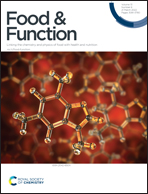Antioxidant properties of lactic acid bacteria isolated from traditional fermented yak milk and their probiotic effects on the oxidative senescence of Caenorhabditis elegans
Abstract
The objectives of the current study were to screen antioxidant lactic acid bacteria (LAB) strains isolated from traditionally fermented Tibetan yak milk, and to evaluate their probiotic effects on the oxidative senescence of Caenorhabditis elegans (C. elegans). A total of 10 LAB isolates were assessed for their antioxidant activity by in vitro assays, and three strains with high activity were selected for an investigation of their probiotic functions in C. elegans. The results indicated that Lactobacillus plantarum As21 showed high anti-oxidant capacity and had a high survival rate (64%) in a simulated gastrointestinal tract. The lifespan of C. elegans treated with As21 was increased by 34.5% compared to the control group. Strain As21 also showed improved motility and enhanced resistance to heat stress and H2O2 stimulation in C. elegans. Moreover, treatment with As21 reduced the production of age-related reactive oxygen species (ROS) and malondialdehyde (MDA) damage and promoted the production of the antioxidants superoxide dismutase (SOD), catalase (CAT) and glutathione GSH. These results suggest that Lactobacillus plantarum strain As21 could be a potential probiotic strain for retarding ageing and could be used in functional foods.



 Please wait while we load your content...
Please wait while we load your content...